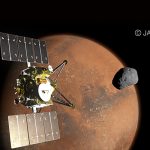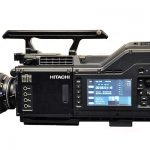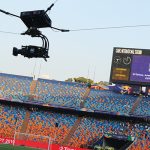BroadcastPro ME brings you highlights from the recently concluded CES that created waves in the broadcast industry with new product launches and tech showcase.
 Consumer Electronic Show (CES) 2019, held in Las Vegas, served as the launch site for a series of transformative technologies and drew a huge audience from around the world. With consumer behaviour dictating a lot of B2B trends, we bring you highlights from CES that got the broadcast industry talking.
Consumer Electronic Show (CES) 2019, held in Las Vegas, served as the launch site for a series of transformative technologies and drew a huge audience from around the world. With consumer behaviour dictating a lot of B2B trends, we bring you highlights from CES that got the broadcast industry talking.
8K is catching up!
Just when the industry and content providers were warming up to the 4K format of high-definition, CES created ripples with Samsung, Sony, LG and TCL unveiling massive 8K TVs, the 98Q900, Z9G (Android TV), Z9 8K OLED TV and TCL X10 QLED 8K TV respectively.
8K resolution has 16 times as many pixels as full HD, and four times as many as 4K Ultra HD. With more than 33 million pixels, viewers can expect crisp detail even in super big screen sizes. Some of these models will be available in stores in 2019. The detailed specifications for all the 8K models will be disclosed in due time.
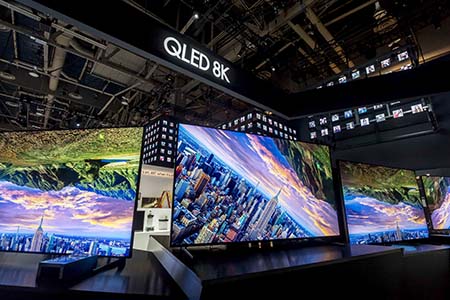
The ever-growing screen sizes are being lauded for their ability to upscale technology, to make even 4K content look better on an 8K display. What remains to be seen, however, is how the unveiling translates to sales.
The lack of large-scale 8K content programming can be a factor in consumers staying away from bringing 8K home. So far, only Japans national broadcaster NHK offers an 8K satellite channel.
Rolling screens at home
Imagine your TV screen retracting when no one is watching! LGs Signature OLED TV R, a 65-inch 4K HDR television, can unfurl from a box with built-in speakers and all the connectivity ports. Creating quite a buzz at CES, the rollable display comes with three modes: Full View (the display fully rolls out to watch TV), Line View (the display is partially unrolled and can show the time, the weather, photos and an ambient scene like a fireplace, as well as stream music and provide access to the home dashboard), and Zero View (the display disappears but you can still listen to music through the 100W built-in Dolby Atmos speakers).
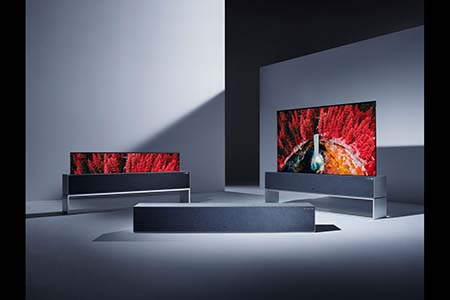
LGs rollable TV is powered by an Alpha 9 Gen 2 processor, which brings a host of advanced features along with better picture and sound quality, compared to its 2018 predecessors. The TV will have both Amazon Alexa and Google Assistant built-in, as well as support for Apple AirPlay 2 wireless technology and HomeKit the former allows users to stream videos, music and photos directly from their Apple devices, while the latter can control the TV using Apples Home app or personal digital assistant Siri.
Apple and Samsung partner
Apple and Samsung seem to have buried the hatchet at CES 2019, launching an exclusive partnership. Samsung will offer iTunes movies and TV and Apple AirPlay 2 support on all its 2019 smart TV models. The new iTunes Movies and TV Shows app will debut in more than 100 countries, while AirPlay 2 support will be available in 190 countries worldwide.
Samsung customers can now access their existing iTunes library and browse the iTunes Store to buy or rent from a selection of hundreds of thousands of movies and TV episodes, including the largest selection of 4K HDR movies. iTunes Movies and TV Shows will work seamlessly with Samsungs smart TV services, such as Universal Guide, the New Bixby and Search, to create a consistent experience across Samsungs platform.
With AirPlay 2 support, Samsung customers will be able to effortlessly play videos, photos, music, podcasts and more from Apple devices directly to Samsung smart TVs, including QLED 4K and 8K TVs, The Frame and Serif lifestyle TVs, and other Samsung UHD and HD models.
Micro LED display: The next big thing?
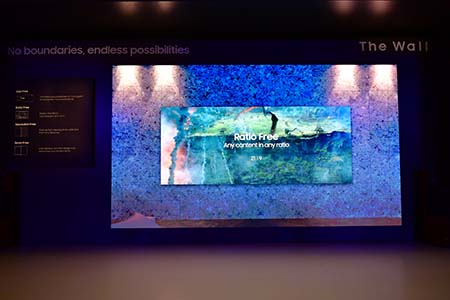 Micro LED technology has come of age lately. At least, the trends at CES 2019 seem to suggest this. Samsung debuted its new ultra-large television with a 219-inch diagonal at CES 2019. The TV, called The Wall, uses the companys Micro LED technology to offer very high brightness and deep inky blacks, for better picture quality. This launch is a step up for Samsung from its 146-inch Micro LED display, launched at CES 2018. Besides the super screen offering, Samsung also offered a 4K Micro LED display in a smaller, more home-friendly 75-inch form factor.
Micro LED technology has come of age lately. At least, the trends at CES 2019 seem to suggest this. Samsung debuted its new ultra-large television with a 219-inch diagonal at CES 2019. The TV, called The Wall, uses the companys Micro LED technology to offer very high brightness and deep inky blacks, for better picture quality. This launch is a step up for Samsung from its 146-inch Micro LED display, launched at CES 2018. Besides the super screen offering, Samsung also offered a 4K Micro LED display in a smaller, more home-friendly 75-inch form factor.
Plessey, a UK optoelectronic technology solutions provider, also demonstrated AR and VR glasses powered by Micro LEDs at CES. Micro LED is a flat panel technology using millions of individually controlled microscopic LEDs emitting their own light. Micro LED is in the running to replace OLED in ultra-thin, bezel-less TV displays. At CES, only LG and Samsung showed working prototypes of 4K Micro LED TVs.
OTT in internet-limited environments
Internet availability for accessing OTT content will soon be passé! Targeting the entertainment needs of travellers, Irdeto launched Control on the Go at CES, a service which enables transport operators to offer a secure onboard video entertainment service with limited or no internet connectivity.
Providing a secure, premium onboard video entertainment service in long-distance transport vehicles without internet connectivity is a great differentiator for plane, train, coach and cruise ship operators. Irdeto Control on the Go delivers the flexibility consumers desire, while offering the robust media protection demanded by content owners to securely deliver premium content.
Control on the Go is highly scalable, capable of issuing any number of licences requested and managing millions of videos. It enables transport operators to offer an extensive library of content to a large number of people with ease, protecting video end-to-end without the need to transfer keys. The solution is pre-integrated with most packagers and encoders on the market, as well as many encryption and playback solutions. It also has a set of APIs that allows easy integration and fast deployment with additional third-party systems.
 In-car entertainment takes you to outer space
In-car entertainment takes you to outer space
Entertainment for car rides went high-tech as well at CES 2019. To redefine in-car entertainment for backseat passengers, Audi with Marvel Studios is bringing an immersive VR experience to passengers. Travel in space and time with Marvels Avengers: Rockets Rescue Run, brought to life by Disney Games and Interactive Experiences for Audi e-tron patrons.
Wearing VR glasses, passengers are transported into a fantasy depiction of outer space. The Audi e-tron functions as a ship manned by the Guardians of the Galaxy, as passengers make their way through an asteroid field together with Rocket, a character in Avengers: Endgame, coming in spring 2019. Every movement of the car is reflected in the experience in real time. If the car turns a tight corner, the player curves around an opposing spaceship in virtual reality. If the Audi e-tron accelerates, the ship in the experience does the same.
Through a subsidiary, Audi Electronics Venture GmbH, Audi has co-founded a start-up company, holoride GmbH, which will commercialise this new form of entertainment through an open platform that will be made available to all carmakers and content developers in the future.
Holoride plans to make this technology available in the next three years, using standard VR glasses for backseat passengers. In the long term, the continued expansion of car-to-X infrastructure could also see traffic events becoming part of the experience: Stopping at traffic lights could introduce unexpected obstacles to a game or interrupt a learning program with a quick quiz.
Audio solutions of the future are here
With so much happening in the visual space, can audio be far behind? CES saw a lot of new tech being introduced in the audio segment, with wireless audio making heads turn and feet tap. Notable introductions this year included Bluesound Pulse Soundbar Gen2i and Pow Audios Bluetooth speaker, Mo. Bluesounds offering enables you to turn a room into a chamber of sonic excellence. Designed to fit under your HD or 4K TV, the Pulse Soundbar 2i is the worlds first multi-room, high-res, wireless home theatre soundbar to feature crystal-clear 24-bit resolution sound and audiophile-grade bass response without a subwoofer.
The Bluesound Player comes with end-to-end (studio speaker) technology known as Master Quality Authenticated (MQA), which captures and delivers master quality audio from your favourite artists recording sessions to any room in your home. Each Bluesound Player includes a decoder and audio renderer for the MQA system, allowing you to hear exactly what the artist recorded and approved in the studio.
Bluesound will soon support Amazons Alexa and AirPlay 2 on Bluesound 2i, allowing you to use your voice to explore music services, select pre-sets, adjust volume levels, switch up songs in different rooms or even group your Players together and play music in perfect sync throughout the house. Simply connect Alexa to your Bluesound system and command your music. With AirPlay, you can listen to your music in perfect sync as you walk from room to room, or play different songs in different rooms and control everything on your iOS device. You can even say the song you want to listen to and where, and let Siri take control of your music experience.
While Bluesounds offering is all flexibility and style, Pow Audios Mo brings you its patented WaveBloom technology, which expands to create an air-filled chamber, resulting in better resonance. Mo delivers huge volume, deep bass, full midrange and crisp highs within a compact package that fits in a pocket when not in use. Pre-orders for Mo will be available soon, with shipments beginning in February. Mo is a portable speaker with an expandable design that doesnt sacrifice bass resonance and delivers huge volume.











































































